Dracaena aletriformis
(Large-leaved dragon-tree)
Grootblaardrakeboom [Afrikaans]; siKhonkhwane
[Swazi]; photsoloma [North Sotho]; Tshila-mbila [Venda]
Life
> eukaryotes >
Archaeoplastida >
Chloroplastida
>
Charophyta > Streptophytina > Plantae (land plants)
> Tracheophyta (vascular plants) > Euphyllophyta > Lignophyta (woody plants)
> Spermatophyta (seed plants) > Angiospermae (flowering
plants) > Monocotyledons > Order: Asparagales
> Family: Asparagaceae > Genus:
Dracaena
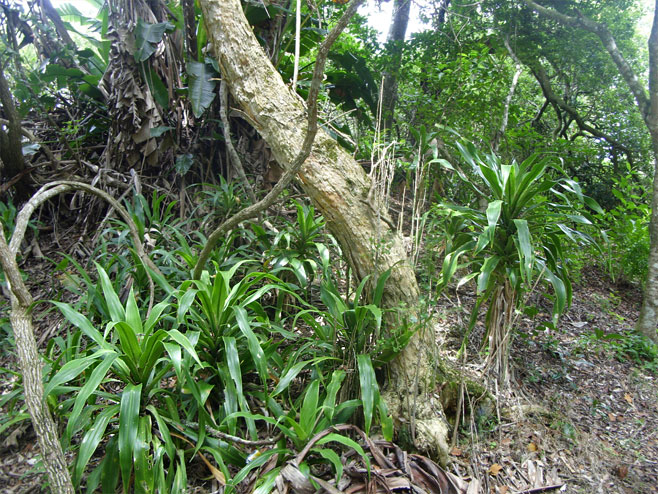 |
|
Dracaena aletriformis, Kei River Mouth,
Eastern Cape, South Africa. [image Quartus Grobler ©, from
iNaturalist] |
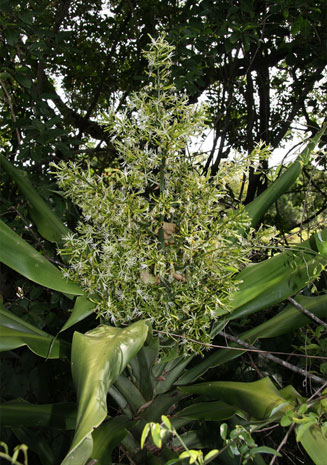 |
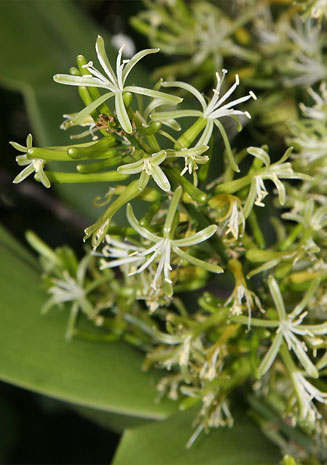 |
|
Dracaena aletriformis, Nseleni Nature
Reserve, KwaZulu-Natal, South Africa. [images
Craig Gibbon ©] |
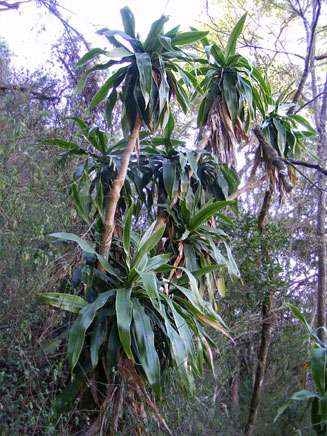 |
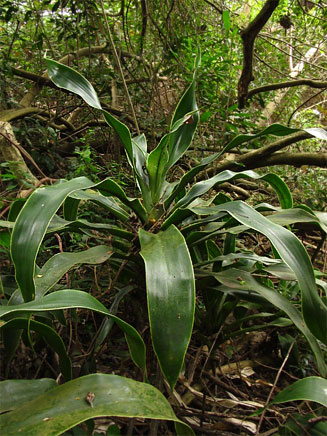 |
|
Dracaena aletriformis, Umgeni River Nature
Reserve, KwaZulu-Natal, South Africa. [image Andrew Deacon ©, from
iNaturalist] |
Dracaena aletriformis, Umhlanga Lagoon,
KwaZulu-Natal, South Africa. [image Lize von Staden ©, from
iNaturalist] |
A shrub or small tree usually with a main stem
topped by a rosette of elongate (usually 60-100 cm long) leaves.
Grows in the shady understorey of forests in South Africa and
Swaziland, its distribution extending from the Eastern Cape to
Limpopo.
Identification
- A shrub or small tree, growing from 1-5 m high. Usually has
a single main stem, but is sometimes branched. Plants often grow
in large clumps.
- The large, leathery leaves are crowded in rosettes at the
ends of stems. They are generally longer than 60 cm (up to 100
cm) without a prominent midrib, thus separating it from
Dracaena mannii (Small-leaved dragon-tree) and Dracaena
transvaalensis (Wolkberg dragon-tree). Leaves are also
longer than 60 cm in Dracaena steudneri (Northern
large-leaved dragon-tree) but this latter species is found in
Zimbabwe, where Dracaena aletriformis is absent.
- The greenish-white flowers are in large sprays up to 1 m
long.
- Fruit are one- or two- lobed and up to 2 cm in diameter,
turning orange-red when ripe.
Distribution and habitat
Found in the under-storey of forests of the
Eastern Cape, KwaZulu-Natal, Gauteng, Limpopo, and Swaziland. I have
seen it in the forests of the Vredefort Dome area, which lies in the
Northwest Province.
Ecological interactions
- Flowers attract insects such as butterflies and bees.
- Fruit are eaten by:
See also ecological interactions listed under
Dracaena.
Phenology
- Flowers in summer from November to February.
- Fruits in late summer, autumn, from February to April.
Uses
- Cultivated in gardens because of its interesting shape.
Plants need to be planted in the shade in deep, humus-rich soil.
Because it like deep shade, it can also be grown as an indoor
plant.
- In the Eastern Cape, the roots are evidently crushed and
used as a wash to drive off evil spirits.
Links
References
- Palgrave, K.C. and Palgrave, M.C. 2002. Trees of Southern Africa.
3rd Edition. Struik Publishers, Cape Town.
- Schmidt, E., Lotter, M., McCleland, W. and Burrows, J.E.
2002. Trees and Shrubs of Mpumalanga and Kruger National Park.
Jacana, Johannesburg.
Text by Hamish Robertson |
